Bull, Mrs (McKechnie Section 2)
See also Section Three
Recorded by Coke (The Art of Silhouette), who refers briefly to Mrs Bull as follows: 'The work in particular of Mrs Bull, another clever woman profilist, who worked 'Opposite the India House' c. 1785, is seldom signed, and almost exactly similar in style to that of Charles.' Fortunately, Coke illustrated an example of her work; presumably he had identified it from the name and the inscription 'opposite the India House', on the back. This must be taken as a prototype example (dating apparently from c. 1788-90) of Mrs Bull's work, and offers the only available basis for identifying other examples. No writer since Coke has produced further documented evidence of Mrs Bull's life or work. Jackson surmises that she may have been the wife of Richard Bull, the miniature painter (fl. 1777-1809). But this seems unlikely, since Bull probably did not come from Dublin to England until 1790 — that is after the period when (as I shall explain) the silhouettes which can reasonably be ascribed to Mrs Bull were painted. Bull sent in exhibits to the Royal Academy 1794-1809. Foskett has no separate entry on Mrs Bull, and there is no evidence that she was a painter of miniatures.
We know that in 1785 Mrs Beetham (q.v.; Section Three) was at her busiest and most successful as a silhouette artist. In this Section I have illustrated under the heading of Mrs Beetham three silhouettes painted on paper, which, although backed with Mrs Beetham's trade labels, are stylistically so similar to Mrs Bull's work that it seems Mrs Bull, as well as W. N. Gardiner (q.v.; Section Three) assisted Mrs Beetham at 27 Fleet Street, London, c. 1785-86 and there painted, amongst others, these three silhouettes. The bust-line of one of them terminates in exactly the same manner as that of Coke's example; the other two are in three quarter-style, and therefore have no termination. 689 690 691
In view of the date of Coke's example, it seems that Mrs Bull (after a year or two spent assisting Mrs Beetham, probably only in the production of paper profiles) had set up on her own by c. 1788, working independently 'Opposite the India House' (the headquarters of the East India Company in Leadenhall Street; demolished in 1924). Mrs Bull's studio, probably rented for only a relatively short time, would have been near the junction of Lime Street with Leadenhall Street. As no dated silhouette has been recorded, it can only be said that, to judge from examples seen, she was there c. 1788-90.
No example from Mrs Beetham’s studio, apparently dating from 1788-90, shows the hand of Mrs Bull. I have therefore illustrated under Mrs Bull's name two unlabelled silhouettes from this period which, on stylistic grounds, must be attributed to her. These, as well as Coke's example and three other silhouettes illustrated under Mrs Beetham's name, are all of men. Other silhouettes have been ascribed by previous writers to Mrs Bull, including some of women, one of which was illustrated by Mayne. I have seen others similar to the example illustrated by Mayne, but none of them are sufficiently similar in style to the illustrated profiles of men to be attributable with certainty to Mrs Bull, and none are signed or inscribed. One silhouette of a woman which may be by Mrs Bull is that of ‘Perdita’, reproduced by Mills.
With regard to style, there is little difference between the silhouettes which Mrs Bull appears to have painted in Fleet Street and those which she painted later in Leadenhall Street. Two of the former, however, which I have seen are painted against a base colour of bluish black, and not in her usual dead-black base colour. This shade might also be seen on work dating from her Leadenhall Street period. (I have not seen this colour on any work executed by Mrs Beetham.) 689
Mrs Bull used gum arabic consistently on all parts of the portrait on which she wanted to indicate deep shadow, but not as a base for the hair. She also used strokes of gum arabic on the collar (deep at the time she was working) to show a realistic `giving' in the middle.
On silhouettes of men a number of individual points of style indicate Mrs Bull's hand. Magnification photographs at the end of this Section show shirt-frills from two silhouettes painted by Mrs Bull: one from her Fleet Street period, the other from her Leadenhall Street period. The sequence of hatching on these two examples can only be from one hand. The closure of the fashionable frock is emphasized by the painting of one large button. The horizontal or vertical stripes on the lapels of the waistcoats fashionable during the 1780s are shown by similar brushwork. Mrs Bull used zigzag hatching to indicate the closure of the waistcoat beneath the cut-away front of the frock.
The artist's treatment of hair is compared with that of A. Charles in other magnification photographs. As may be seen from these, the whole of the wig is shown, as in Charles' work, but the brush-strokes (against a background of thinned pigment) are shorter than those of Charles. Men's pigtail ribbons are best identified by studying the illustrations of Mrs Bull's silhouettes, from which it can be noted how the formation differs from that both in Mrs Beetham's work and in Charles's. Examples from the Fleet Street period have a more 'fly-away' look than those seen on work of the Leadenhall Street period, in which the formation is a little more restrained.
Silhouettes terminating in a bust-line finish show the same shape throughout. Two of the Fleet Street examples are in three-quarter length and continue to the base of the oval. The arm, finished with a slight concavity, juts out beyond the rest of the line, which is finished with a plain convexity.
On the silhouette of ‘Perdita’ the sitter's hair (as far as one can judge from Mills's illustration) appears to have been painted with the short, curling strokes typical of Mrs Bull's style. The shading on the hat closely resembles that on men's waistcoat lapels. Much artistry is shown in the rendering of feathers and ribbons. The bust-line finish closely resembles that of the profiles of men. Mrs Beetham, a superb silhouette artist herself, is unlikely to have employed an artist whose work was of poor calibre and this strengthens the attribution of ‘Perdita’ to Mrs Bull.
It should be noted that Mrs Bull’s work is painted on the same kind of rather thick paper that was used by Mrs Beetham.
No trade label of Mrs Bull is, as far as I know, extant. It is not known if the artist’s name, and the words ‘Opposite the India House’, were printed or hand-written on the example recorded by Coke.
Ills. 696-698 979 981 989 990
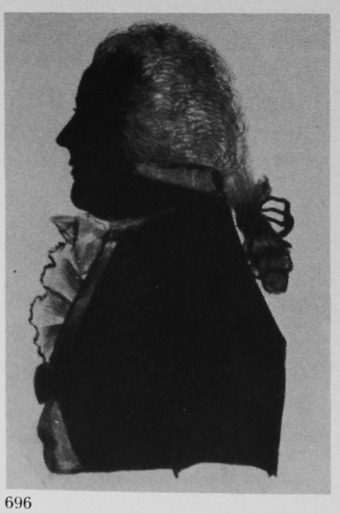
Unknown man
Silhouette painted on thick paper, with detail in thinned water-colour, stressed with gum Arabic.
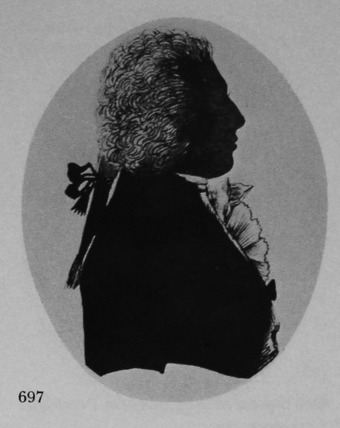
Unknown man
Silhouette painted on thick paper
c. 1788-89
Attributed on stylistic grounds to Mrs Bull, this silhouette was once attributed to A. Charles, which indicated that it cannot have borne a trade label.
From E. Nevill Jackson, ‘The History of Silhouettes’ (1911), by courtesy of the ‘Connoisseur’
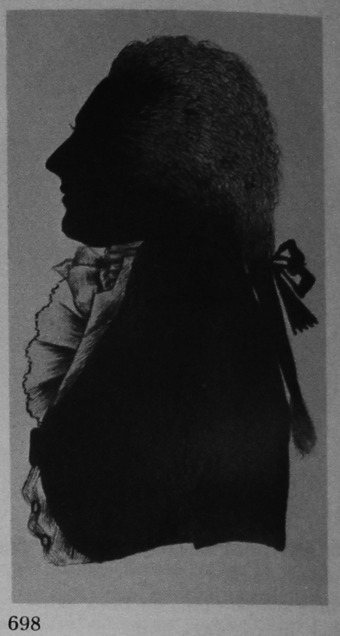
Unknown man
Silhouette painted on thick paper
c. 1788-90
3 ¾ x 3in./96 x 77mm.
Attributed on stylistic grounds to Mrs Bull, this silhouette bears no trade label.
Author’s collection
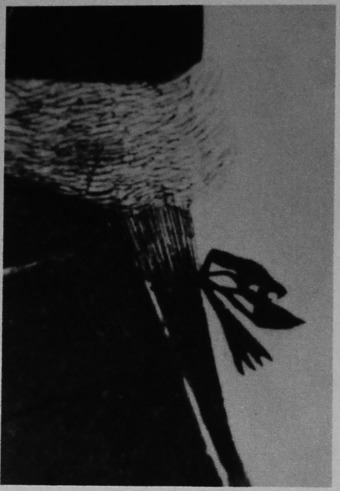
Man’s hair. Detail from a silhouette, painted on card, bearing Mrs Beethams Trade Label No. 4
The style strongly suggests the hand of Mrs Beetham’s assistant, Mrs Bull. (691)
J. A. Pollak collection
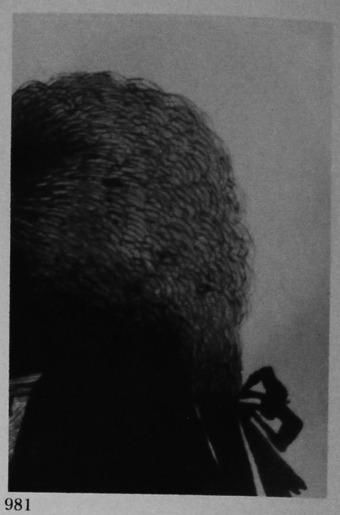
Man’s hair. Detail from a silhouette probably by Mrs Bull. The hair is drawn with far shorter strokes than those used by A. Charles when painting hair. (698)
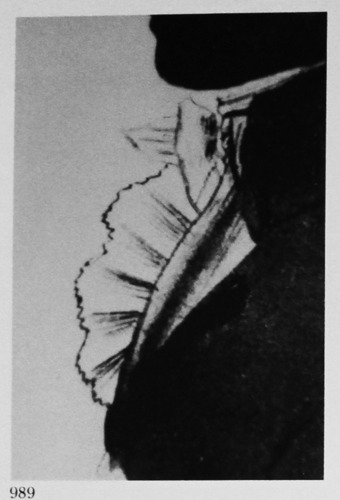
Man’s shirt-frill. Detail from a silhouette bearing Mrs Beetham’s Trade Label No. 5. Possibly by Mrs Bull; the similarity of this detail with that shown in 993 suggests the period of Mrs Bull’s employment in Mrs Beetham’s studio at 27 Fleet Street. (691)
J. A. Pollak collection
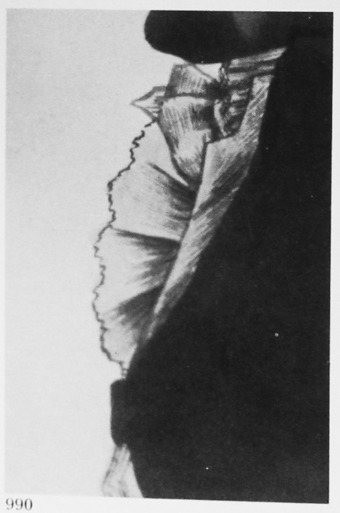
Man’s shirt-frill. Detail from a silhouette attributed to Mrs Bull, during her Leadenhall Street period. (698)
